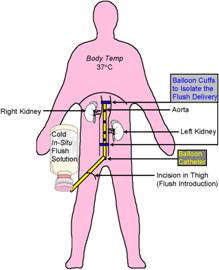Biomedical, Engineering and physical science
In-Situ Preservation Bridge Solution and Device for Non-Heart Beating Donors
The technology
Market need
There are more than 90,000 patients in U.S waiting for donor organs, two thirds of which are on the national kidney waiting list. In the year 2005, only 16,477 kidney transplants were performed. Currently, there are no effective methods for preserving and bridging organs from non-heart beating donors. Due to the lack of preservation methods, most kidneys harvested from these donors are not usable for transplantation due to exposure to lethal warm ischemia.
Technology summary
This invention provides an in-situ flush solution that activates known biochemical pathways in kidney cells so that they can survive the fatal warm ischemic period prior to harvest. Activation of these survival mechanisms provides the time necessary for the kidneys to be harvested and preserved with conventional techniques. This system is minimally invasive, effective, and has the potential of being used by ER physicians and trauma surgeons. Therefore, it has the potential to greatly expand the donor pool of available kidneys. This invention also has the potential to be applied to ex-vivo donation of intestine, liver, heart, and pancreas. It may also be useful in preserving organs from conventional, heart beating donors by enhancing the storage environment and in preserving organs from other extended criteria donors. As proven in animal experimentation, there is a clear and significant advantage to using the bridge flushing in-situ for non-heart beating kidney donation.

Technology status
Preclinical testing in large animal transplant models
